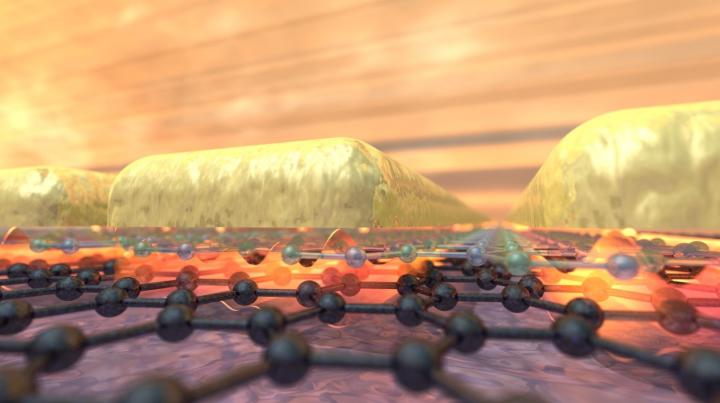New record on squeezing light to one atom: Atomic Lego guides light below one nanometer

This is an artistic impression of the squeezed light (plasmon) in between the metal and graphene, separated by just one a one-atom thick dielectric. Credit: ICFO
New techniques have been on the rise searching for ways to confine light into extremely tiny spaces, millions of times smaller than current ones. Researchers had earlier on found that metals can compress light below the wavelength-scale (diffraction limit), but more confinement would always come at the cost of more energy losses. This paradigm has now been shifted, by using graphene instead!
In a recent study published in Science, ICFO researchers have been able to reach the ultimate level of confinement of light. That is, they have been able to confine light down to a space one atom thick in dimension, the smallest confinement ever possible. The work was led by ICREA Prof at ICFO Frank Koppens and carried out by David Alcaraz, Sebastien Nanot, Itai Epstein, Dmitri Efetov, Mark Lundeberg, Romain Parret, and Johann Osmond from ICFO, and performed in collaboration with University of Minho (Portugal) and MIT (USA).
The team of researchers used stacks (heterostructures) of 2D materials, and built up a completely new nano-optical device, as if it were atom-scale Lego. They took a graphene monolayer (semi-metal), and stacked onto it a hexagonal boron nitride (hBN) monolayer (insulator), and on top of this deposited an array of metallic rods. They used graphene because this material is capable of guiding light in the form of “plasmons”, which are oscillations of the electrons, interacting strongly with light.
They sent infrared light through their devices and observed how the plasmons propagated in between the metal and the graphene. To reach the smallest space conceivable, they decided to reduce as much as possible the gap between the metal and the graphene to see if the confinement of light remained efficient, e.g. without additional energy losses.
Strikingly enough, they saw that even when a monolayer of hBN was used as a spacer, the plasmons were still excited by the light, and could propagate freely while being confined to a channel of just on atom thick. They managed to switch this plasmon propagation on and off, simply by applying an electrical voltage, demonstrating the control of light guided in channels smaller than one nanometer of height.
The results of this discovery enable a completely new world of opto-electronic devices that are just one nanometer thick, such as ultra-small optical switches, detectors and sensors. Due to the paradigm shift in optical field confinement, extreme light-matter interactions can now be explored that were not accessible before. What is really exciting is that the atom-scale lego-toolbox of 2d materials has now also proven to be applicable for many types of completely new materials devices where both light and electrons can be controlled even down to the scale of a nanometer.
###
This research has been partially supported by the European Research Council, the European Graphene Flagship, the Government of Catalonia, Fundació Cellex and the Severo Ochoa Excellence program of the Government of Spain.
REFERENCE
Probing the Ultimate Plasmon Confinement Limits with a van der Waals heterostructure
David Alcaraz Iranzo, Sebastien Nanot, Eduardo J. C. Dias, Itai Epstein, Cheng Peng, Dmitri K. Efetov, Mark B. Lundeberg, Romain Parret, Johann Osmond, Jin-Yong Hong, Jing Kong, Dirk R. Englund, Nuno M. R. Peres, Frank H.L. Koppens
Science, DOI 10.1126/science.aar8438 (2018)
LINKS
Link to the research group led by ICREA Prof. at ICFO Frank Koppens: https:/
Link to the Graphene @ ICFO: http://graphene.
ABOUT ICFO
ICFO – The Institute of Photonic Sciences, member of The Barcelona Institute of Science and Technology, is a research center located in a specially designed, 14.000 m2-building situated in the Mediterranean Technology Park in the metropolitan area of Barcelona. It currently hosts 400 people, including research group leaders, post-doctoral researchers, PhD students, research engineers, and staff. ICFOnians are organized in 26 research groups working in 60 state-of-the-art research laboratories, equipped with the latest experimental facilities and supported by a range of cutting-edge facilities for nanofabrication, characterization, imaging and engineering.
The Severo Ochoa distinction awarded by the Ministry of Science and Innovation, as well as 15 ICREA Professorships, 30 European Research Council grants and 6 Fundació Cellex Barcelona Nest Fellowships, demonstrate the centre's dedication to research excellence, as does the institute's consistent appearance in top worldwide positions in international rankings. From an industrial standpoint, ICFO participates actively in the European Technological Platform Photonics21 and is also very proactive in fostering entrepreneurial activities and spin-off creation. The center participates in incubator activities and seeks to attract venture capital investment. ICFO hosts an active Corporate Liaison Program that aims at creating collaborations and links between industry and ICFO researchers. To date, ICFO has created 6 successful start-up companies.
Media Contact
All latest news from the category: Physics and Astronomy
This area deals with the fundamental laws and building blocks of nature and how they interact, the properties and the behavior of matter, and research into space and time and their structures.
innovations-report provides in-depth reports and articles on subjects such as astrophysics, laser technologies, nuclear, quantum, particle and solid-state physics, nanotechnologies, planetary research and findings (Mars, Venus) and developments related to the Hubble Telescope.
Newest articles

First-of-its-kind study uses remote sensing to monitor plastic debris in rivers and lakes
Remote sensing creates a cost-effective solution to monitoring plastic pollution. A first-of-its-kind study from researchers at the University of Minnesota Twin Cities shows how remote sensing can help monitor and…

Laser-based artificial neuron mimics nerve cell functions at lightning speed
With a processing speed a billion times faster than nature, chip-based laser neuron could help advance AI tasks such as pattern recognition and sequence prediction. Researchers have developed a laser-based…

Optimising the processing of plastic waste
Just one look in the yellow bin reveals a colourful jumble of different types of plastic. However, the purer and more uniform plastic waste is, the easier it is to…


